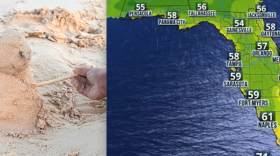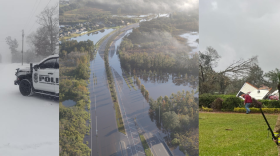Anglers have long theorized that the mighty tarpon, a brawny fish that draws anglers from around the world as part of a $6 billion U.S. sportfishing industry, migrated vast distances in search of warm water and food.
Now, a new study drawing on two decades worth of tracking data shows just how far: across the Gulf of Mexico to the Yucatan.
“We were tagging fish in Vera Cruz down in the lower Bay of Campeche and they were going up to the mouth of the Mississippi. So immediately we realized, holy moly, these fishes are moving literally thousands of kilometers,” said University of Miami fisheries ecologist Jerry Ault, a co-author on the study and chair of the Rosenstiel School of Marine and Atmospheric Science department of marine ecosystem.
More importantly, the migration pattern suggests tarpon found in the U.S., Caribbean and Mexico all belong to the same population. In other words, U.S. fish that must be released once caught lose that protection when they cross international borders.

The study, published this month in the journal Fish and Fisheries, suggests managers need to correct the flaw by coming up with an international rule, like the kind applied to tuna and marlin or other billfish.
“In the international world, in Mexico and Central America, it’s catch and keep and kill,” said lead author and UM marine biologist Jiangang Luo. “The bluefin tuna have an international organization to protect them. There’s no such policies or organizations to protect the tarpon.”
And tarpon are especially vulnerable to fishing pressure, Ault said. They can live up to 50 years, but don’t start reproducing until they’re 6 or 7 years old.
“So we want to keep the spawning biomass at a particular level and above a threshold,” he said. “To do that we have to coordinate with our partners to the south.”
When it comes to sportfishing, tarpon sit atop the trophy case, drawing big game hunters like Ernest Hemingway and baseball legend Ted Williams to the Florida Keys. They were once so plentiful in the Gulf of Mexico that world records could be found in tiny towns like Homasassa, north of Tampa, and presidents headed to Port Aransas, Texas.
But over the years, the tarpon started to decline. In 2018, they were among the fish hit hard by a toxic red tide in the Gulf. With mostly anecdotal information and little scientific data, it was hard to determine why, Ault said.
That changed during a conversation with fly-fishing legends Billy Pate, who held the world record for the biggest tarpon caught on the lightest fly line; Stu Apt, another record-holder whose fishing fly appeared on a stamp; and George Hommell, Williams’ fishing guide.
“These guys knew what was going on and they were lamenting the fact that [fishing] used to be better and asking why,” Ault said.
Then Pate asked: “I wonder if those fish that we call ours in the spring and summer, in fact are theirs in the winter, inferring somewhere south of the U.S. border,” Ault said.
That inspired Ault to launch a widespread tracking study that eventually spanned 18 years and included nearly 300 tarpon tagged with satellite trackers. Over the years, the tracking information confirmed what anglers had long suspected: that fish wintering in Florida were heading up the coast to Virginia and the Chesapeake Bay during the summer.
But the full data provided a more detailed look at how tarpon, which can weigh well over 200 pounds and have both gills and an air bladder that allows them to breathe air, use the ocean.
“Tarpon can literally overnight go from pure marine seawater into freshwater,” Ault said.
In addition to the massive migration, the study added to the understanding of one of the remaining unknowns about tarpon: how they reproduce. Scientists know before the new and full moon, tarpon head offshore and dive to depths up to 400 feet. They believe the deepwater pressure helps the fish release sperm and eggs. But exactly when and where remains a mystery.
The tracking data suggests spawning locations were clustered along a deep coral tract in the Florida Straits south of the Keys and in northeast Veracruz, Mexico, an area where there are no protections.
Part of the protection quandary lies in the regulatory process. Luo said rules usually apply to species commercially fished for food and considered more valuable. But he said the tarpon fishery — Ault says its value in Florida surpasses the citrus industry — justifies the protection too.
“If it can work for other species, why not tarpon?” he said. “Can you imagine if they were delicious? There would be no tarpon left.”
Copyright 2020 WLRN 91.3 FM. To see more, visit WLRN 91.3 FM. 9(MDAyMTYyMTU5MDEyOTc4NzE4ODNmYWEwYQ004))








